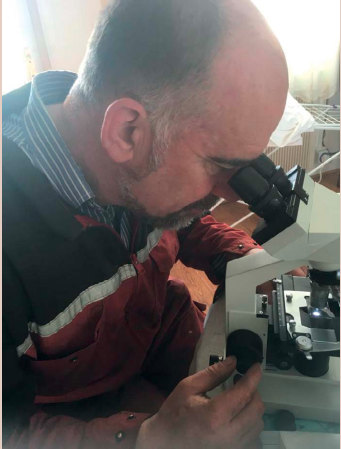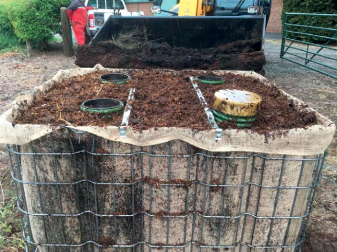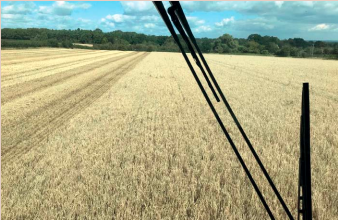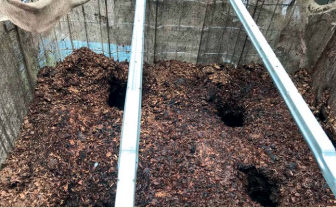Tim Parton looks to the future in farming and sees microbes taking a leading part in crop and animal production

To quote Rudyard Kipling,
“If you can keep your head when all about you Are losing theirs….”
– seems quite appropriate at the moment. Something, as farmers, we are good at living with, is uncertainty: weather conditions – out of our control; corn prices – out of our control; government legislation out of our control; DEFRA subsidies out of our control. I could rattle on about the suffering and anxiety surrounding the weather, the harvest and re-drilling. Instead, I chose to focus on what I am doing to “keep my head”; concentrating on the things I have control over: Buying my staff breakfast, or an evening drink on those long days of harvest: Thanking Pontesbury Tractors for coming out of hours to repair machinery, so I can get on harvesting in the dry weather before the next downfall of rain: Turning around the disappointment that crop yields are down (remember wet winter and baking Spring?), trusting my gut feeling wheat prices will rise, thus leading to an increased return for my low yield crops.

Challenges faced head on can reveal new ways of working with nature, seeing how nature survives through extenuating circumstances can be an awakening for the human caretaker. On the farm here I have been modifying the 750a (yet again!) with the addition of an air pump on the drill liquid system. This is for two reasons; the first being to keep the biological brew aerated, the second to keep the mix agitated to stop any settling out in the bottom of the tank. This has been done with the help of Trevor Tappin (TT Engineering) and has so far worked well.

Another new move for me has been the introduction of the Johnson Su static bio reactor, with thanks to Andrew Jackson for the introduction to the regenerating soil diversity system. This is to make a richer microbial compost over the next 12 months in order to apply as a drench at drilling, through the peristaltic pumps: in addition to making compost teas. The real magic of the system is that you only really need two kilogrammes per hectare which will reintroduce a varied biology back into the soil, which mimics the process that would occur on land had it been grazed with livestock. Thus, resulting in improved soil fertility.
As Dr David Johnson, molecular biologist and research scientist says “…. microbes are the backbone of every organism and eco system on the planet….”. Dr Johnson goes on to say that they are involved in human brain development and have a part to play in mental health issues such as anxiety, depression, autism, arthritis to name but a few; being responsible for a large portion (80%) of our immune system. I foresee a future of microbes replacing antibiotics to fight infections, as diseases continue to show resistances to the overuse of antibiotics in medicine.

Doing a similar job on the plants’ immune system you can see why I am keen to put the new system into practice. Dr Johnson has seen 2750 different species of bacteria within compost, with counts of 83 million bacteria and 10 million fungal spores in samples used per square foot, leading to more nutrients becoming available. This in turn leading to an increase of carbon being sequestrated into the soil due to healthier, larger plants.

The reactors are filled as shown in the picture. I am trying different recipes which I will evaluate with a microscope to try and assess fungal to bacteria ratios. The pipes are added to allow air into the bacteria as the compost does not want to be more than twelve inches away from air. Water is added to the compost to keep the correct moisture content. The pipes are removed after 24 hours once the compost has bound together leaving an air filled column.

This year once again I have tried to continue to use biology for disease control. This has worked yet again fantastically well on fusarium and brown rust. Yellow rust has presented more of a problem, resulting in the use (much to my disappointment) of some epoxiconazole. On the positive side it allowed me to learn a lot more about the disease and by doing a lot of leaf tissue tests, Nick Woodyatt (Aiva Fertilisers) and I have a plan for the coming year to once again move still further away from fungicides. Once the nutrition of the plant is right it will not be susceptible to disease. A healthy plant can fight off fungal attacks. In this situation foliar applications of nutritional elements come into their own.

As in a dry Spring such as the one we have just experienced, biology in soil does not function as well, resulting in nutritional deficiencies within the plant. Thus, in my opinion, we will always need to step in and keep the plant nutritionally balanced. This does not really concern me as foliar applications are seven times more efficient than soil applied nutrients. This is far less polluting to the environment in which we live.
Another move for me is to start and monitor the Eh of the plant using a redox monitor, which is a measurement of available electrons in the plant, as well as continuing to measure pH – (availability of protons in the plant). The two complement each other. As I become more familiar with the test it will aid my making decisions on nitrogen requirement and other nutrition, in order for me to keep a healthy plant that will be able to resist disease and fight off pest attack. I believe this will further reduce the need for any fungicide requirements. Another successful trial has been carried out in a Spring barley field following a rye, vetch and bean cover crop.
The following Spring barley crop has only received 40 kilos of applied nitrogen, the remainder being made up of amino acids. No fungicides have been applied to the crop, just biology and the correct nutrition. The combine yield monitor has revealed no difference compared to the more conventional grown barley. However, the real difference has been the fact that the crop had no small grains (as we grade all our grain) and was a much bolder sample. Sample results will reveal a true comparison, but I already feel that the trial barley show what can be achieved from healthy soil, with the correct nutrition. It is all about working with Nature, not against her.
One thing is certain, through these uncertain times, soil will continue to live and evolve, and we must too: and if we do
“…. you’ll be a Man, my son!”
I wish everybody a successful autumn and growing year.